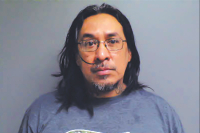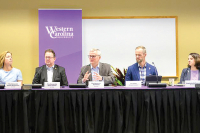Room tax increase isn’t a slam dunk

Every few years, elected officials at the local and county levels of government dribble the ball down the court, passing it back and forth while advancing toward the hoop with the kind of unselfish teamwork that usually results in an easy layup.
But Haywood County’s hotel room occupancy tax increase hasn’t yet gone through the hoop. Rep. Michele Presnell, R-Burnsville, blocked the most recent shot at the increase in 2013.
 Now, local officials again have the ball in their court, hoping to convert their rebound into two points.
Now, local officials again have the ball in their court, hoping to convert their rebound into two points.
And the clock is ticking; on Jan. 25, the Haywood County Tourism Development Authority unanimously passed a resolution calling for an increase in the county’s tax on overnight stays in hotel rooms from 4 percent to 6 percent.
The game plan is similar to the 2013 effort — agree on some guidelines, determine where the money goes, ask for supportive resolutions from municipalities and put two points on the board before the buzzer sounds.
To do so, however, they’ll again have to get past Presnell, who played tenacious defense last time. In 2013, Sen. Jim Davis, R-Franklin, and Rep. Joe Sam Queen, D-Waynesville, took the ball from local officials but were stymied in their attempt to pass the bill.
Related Items
Further, Presnell may have more defensive help this time around. Queen — who supported the measure as long as his constituency wanted it — was defeated in 2016 by Bryson City Republican Mike Clampitt. Clampitt told The Smoky Mountain News in November he wanted to hear from the TDA, the chambers of commerce and the county commissioners before making any decisions on a then-rumored renewed effort.
The only undisputable argument put forth against raising the room occupancy tax is just that — it’s a tax. Given the anti-tax statements Clampitt made during his campaign, his support is far from assured.
While running for reelection, Davis said he’d leave it up to voters to decide through a referendum on the ballot, meaning he’s neutral on the matter, at best.
Also in November, Presnell said “I do not vote for any occupancy tax — not just in my district. It’s just an additional tax. It’s not a tax on the people that live there, but it is on the people that visit there.”
Presnell did, however, indicate her willingness to listen to her constituents on the matter. When she does, she’ll again find near-unanimous support for the hike on a local level.
Every Haywood County commissioner supported the idea during the election. Executive Director of the Haywood Economic Development Council Mark Clasby said in November that the EDC still supports it, and spoke in favor of it before the TDA in January. Local officials from Waynesville to Clyde to Canton support it.
Even some of the previous measure’s opponents support the current version.
Maggie Valley Alderman Mike Eveland — a member of the TDA board and manager of Maggie Valley Inn — voted in favor of the TDA resolution, which was presented to the TDA board by Maggie Valley Alderman Phillip Wight.
Wight is the only remaining elected official who voted no on the previous proposal to increase the occupancy tax. Since that time, the TDA has left approximately $1.2 million on the table.
Once presented, the resolution wasn’t without discussion, although it might be overkill to call TDA member Pratik Shah’s statements “opposition.”
Shah, general manager of the Best Western Smoky Mountain Inn in Waynesville, recognized the anti-tax argument, stating that tourists have a “finite budget” and “have to make a decision on how they want to spend that budget.”
But the crux of his concerns during the meeting — in which he indicated he’d vote ‘no’ on the resolution — centered around spending accountability.
“I just wanted to make sure that funds we’re going to be asked to collect are going to be used to turn around and generate economic development in Haywood County,” he said in an interview last week.
Shah refused to cite specifics or whether he thought the TDA wasn’t putting heads in beds, but his spending concerns were indicative of the opposition the previous plan saw.
He eventually voted yes on the resolution after TDA board members allayed his concerns, stressing the greater role each zip code would have in allocating revenue under the new plan.
TDA Chairman Lyndon Lowe explained how that new plan compares to the old.
“It’s very similar, except that everything came back [to the TDA] as a lump sum [under the old plan],” he said. “But the new proposal has half of that coming back to the zip codes, so they feel better about it.”
With competing local ideologies aligned — both on the income and the expenditure side of the equation — and the clock continuing to tick toward the March 29 deadline for the filing of local bills, will local leaders be able to convince Presnell to play ball?
“I don’t know,” said Lowe. “Since Phil Wight feels more confident in it, I feel pretty good about it. But I just don’t know.”
How the tax works
Understanding how the room occupancy tax is collected and spent is a fairly simple process, but as always, the devil is in the details.
The North Carolina General Assembly enabled both counties and municipalities to collect room occupancy taxes in 1983; since then, guests renting non-exempt cabins, condos, homes, hotel rooms and B&Bs have paid a small percentage of their rental rate to the owner, who collects and remits the money to the county and municipality each month.
More than 80 of the state’s 100 counties and more than 90 of the state’s 533 municipalities have such a tax.
In most — including Haywood County, which charges 4 percent — revenue is administered by a Tourism Development Authority.
That 4 percent is divided into two accounts. Into one goes 75 percent of revenue; from that account, two-thirds of the revenue must be used for promotion of the county itself, and the remaining one-third must be used for tourism-related expenses.
Into the other account goes the remaining 25 percent of revenue; that account in turn is further divided into one separate account each for Canton, Clyde, Lake Junaluska, Maggie Valley and Waynesville, based on zip codes.
Within those zip codes, two-thirds of revenue must go toward promotion of that jurisdiction, with the remaining one-third to be spent on tourism-related expenses within the jurisdiction.
Haywood County’s TDA collected $303,818 in the 1 percent account alone from July 1, 2015, through June 30, 2016.
All five municipalities experienced moderate growth over the previous year, with Clyde posting 82 percent growth and Lake Junaluska posting 41 percent growth. Maggie Valley grew 8 percent and Waynesville 20 percent, collecting $94,751.
Since 2008, Waynesville’s collections have topped $600,000 and helped fund events like Folkmoot and the Apple Harvest Festival.









